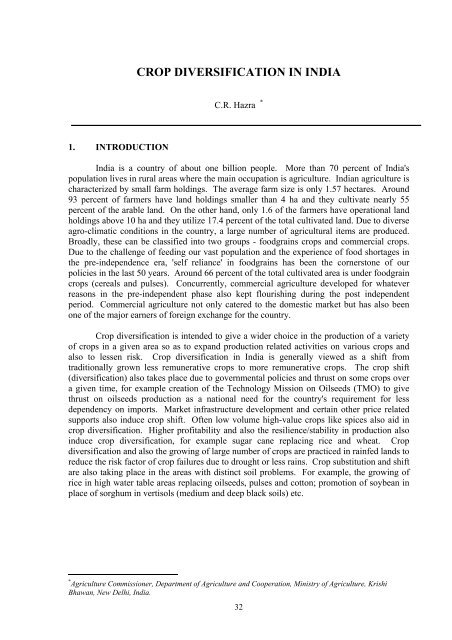Crop Diversification in the Asia-Pacific region - United Nations in ...
Crop Diversification in the Asia-Pacific region - United Nations in ...
Crop Diversification in the Asia-Pacific region - United Nations in ...
- No tags were found...
Create successful ePaper yourself
Turn your PDF publications into a flip-book with our unique Google optimized e-Paper software.
CROP DIVERSIFICATION IN INDIAC.R. Hazra *1. INTRODUCTIONIndia is a country of about one billion people. More than 70 percent of India'spopulation lives <strong>in</strong> rural areas where <strong>the</strong> ma<strong>in</strong> occupation is agriculture. Indian agriculture ischaracterized by small farm hold<strong>in</strong>gs. The average farm size is only 1.57 hectares. Around93 percent of farmers have land hold<strong>in</strong>gs smaller than 4 ha and <strong>the</strong>y cultivate nearly 55percent of <strong>the</strong> arable land. On <strong>the</strong> o<strong>the</strong>r hand, only 1.6 of <strong>the</strong> farmers have operational landhold<strong>in</strong>gs above 10 ha and <strong>the</strong>y utilize 17.4 percent of <strong>the</strong> total cultivated land. Due to diverseagro-climatic conditions <strong>in</strong> <strong>the</strong> country, a large number of agricultural items are produced.Broadly, <strong>the</strong>se can be classified <strong>in</strong>to two groups - foodgra<strong>in</strong>s crops and commercial crops.Due to <strong>the</strong> challenge of feed<strong>in</strong>g our vast population and <strong>the</strong> experience of food shortages <strong>in</strong><strong>the</strong> pre-<strong>in</strong>dependence era, 'self reliance' <strong>in</strong> foodgra<strong>in</strong>s has been <strong>the</strong> cornerstone of ourpolicies <strong>in</strong> <strong>the</strong> last 50 years. Around 66 percent of <strong>the</strong> total cultivated area is under foodgra<strong>in</strong>crops (cereals and pulses). Concurrently, commercial agriculture developed for whateverreasons <strong>in</strong> <strong>the</strong> pre-<strong>in</strong>dependent phase also kept flourish<strong>in</strong>g dur<strong>in</strong>g <strong>the</strong> post <strong>in</strong>dependentperiod. Commercial agriculture not only catered to <strong>the</strong> domestic market but has also beenone of <strong>the</strong> major earners of foreign exchange for <strong>the</strong> country.<strong>Crop</strong> diversification is <strong>in</strong>tended to give a wider choice <strong>in</strong> <strong>the</strong> production of a varietyof crops <strong>in</strong> a given area so as to expand production related activities on various crops andalso to lessen risk. <strong>Crop</strong> diversification <strong>in</strong> India is generally viewed as a shift fromtraditionally grown less remunerative crops to more remunerative crops. The crop shift(diversification) also takes place due to governmental policies and thrust on some crops overa given time, for example creation of <strong>the</strong> Technology Mission on Oilseeds (TMO) to givethrust on oilseeds production as a national need for <strong>the</strong> country's requirement for lessdependency on imports. Market <strong>in</strong>frastructure development and certa<strong>in</strong> o<strong>the</strong>r price relatedsupports also <strong>in</strong>duce crop shift. Often low volume high-value crops like spices also aid <strong>in</strong>crop diversification. Higher profitability and also <strong>the</strong> resilience/stability <strong>in</strong> production also<strong>in</strong>duce crop diversification, for example sugar cane replac<strong>in</strong>g rice and wheat. <strong>Crop</strong>diversification and also <strong>the</strong> grow<strong>in</strong>g of large number of crops are practiced <strong>in</strong> ra<strong>in</strong>fed lands toreduce <strong>the</strong> risk factor of crop failures due to drought or less ra<strong>in</strong>s. <strong>Crop</strong> substitution and shiftare also tak<strong>in</strong>g place <strong>in</strong> <strong>the</strong> areas with dist<strong>in</strong>ct soil problems. For example, <strong>the</strong> grow<strong>in</strong>g ofrice <strong>in</strong> high water table areas replac<strong>in</strong>g oilseeds, pulses and cotton; promotion of soybean <strong>in</strong>place of sorghum <strong>in</strong> vertisols (medium and deep black soils) etc.* Agriculture Commissioner, Department of Agriculture and Cooperation, M<strong>in</strong>istry of Agriculture, KrishiBhawan, New Delhi, India.32
















